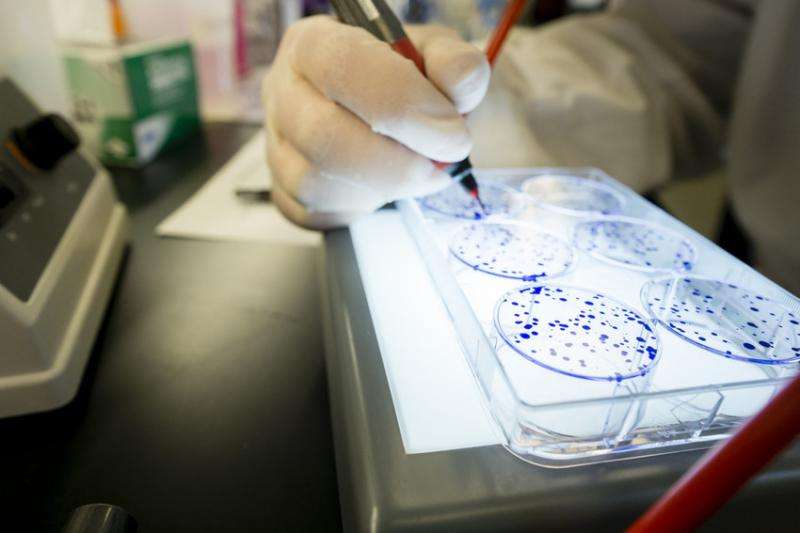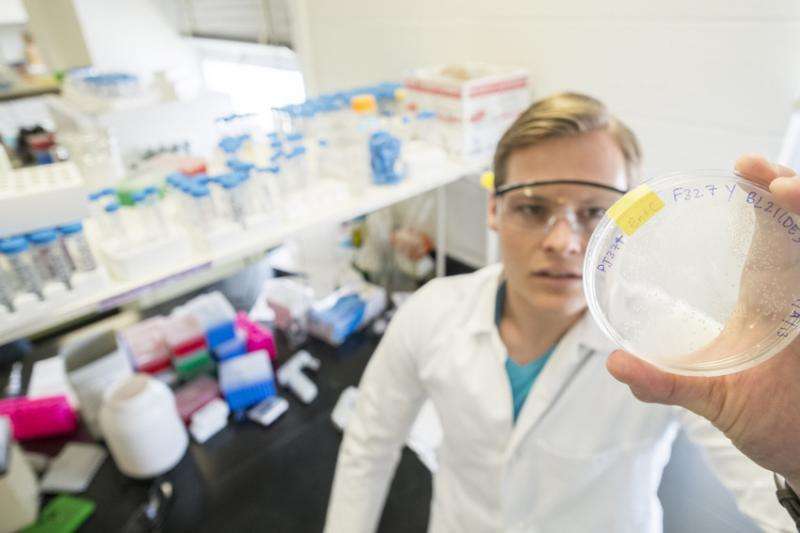Breakthrough finds molecules that block previously 'undruggable' protein tied to cancer

A team of scientists at the University of Kansas has pinpointed six chemical compounds that thwart HuR, an "oncoprotein" that binds to RNA and promotes tumor growth.
The findings, which could lead to a new class of cancer drugs, appear in the current issue of ACS Chemical Biology.
"These are the first reported small-molecule HuR inhibitors that competitively disrupt HuR-RNA binding and release the RNA, thus blocking HuR function as a tumor-promoting protein," said Liang Xu, associate professor of molecular biosciences and corresponding author of the paper.
The results hold promise for treating a broad array of cancers in people. The researcher said HuR has been detected at high levels in almost every type of cancer tested, including cancers of the colon, prostate, breast, brain, ovaries, pancreas and lung.
"HuR inhibitors may be useful for many types of cancer," Xu said. "Since HuR is involved in many stem cell pathways, we expect HuR inhibitors will be active in inhibiting 'cancer stem cells,' or the seeds of cancer, which have been a current focus in the cancer drug discovery field."
HuR has been studied for many years, but until now no direct HuR inhibitors have been discovered, according to Xu.

"The initial compounds reported in this paper can be further optimized and developed as a whole new class of cancer therapy, especially for cancer stem cells," he said. "The success of our study provides a first proof-of-principle that HuR is druggable, which opens a new door for cancer drug discovery. Many other RNA-binding proteins like HuR, which are so far undruggable, can also be tested for drug discovery using our strategy."
The research team evaluated about 6,000 compounds from both the KU Chemical Methodologies and Library Development Center and the Food and Drug Administration in a process known as "High Throughput Screening," hunting for compounds that obstruct HuR's interface with healthy human RNA.
The KU researchers confirmed the potential of the most promising compounds with cutting-edge techniques like Amplified Luminescent Proximity Homogeneous Assay, surface plasmon resonance, ribonucleoprotein immunoprecipitation assay and luciferase reporter functional studies—verifying that six compounds with a similar "scaffold" could be starting points of novel cancer drugs to target the oncoprotein HuR.
"A cancer-causing gene, or oncogene, makes RNA, which then makes an oncoprotein that causes cancer or makes cancer cells hard to kill, or both," Xu said. "This is the problem we're trying to overcome with precision medicine."
The scientist said the HuR-RNA binding site is like a long, narrow groove, not a well-defined pocket seen in other druggable proteins targeted by many current cancer therapies.

"HuR tightly binds to RNA like a hand," Xu said. "The HuR protein grabs the 'rope'—or the RNA—at a site called 'ARE' on the rope. We aimed to find a small-molecule compound that makes the hand release the rope by competing with ARE of the RNA."
The research took more than 3 1/2 years and involved the collaboration of chemists, cancer biologists, computer modeling experts, biochemists and biophysicists at KU—notably the labs of Xu, Jeffrey Aubé in the Department of Medicinal Chemistry and Jon Tunge in the Department of Chemistry.
Grants from the National Institutes of Health, along with funding from the state of Kansas, the Hall Family Foundation and Bold Aspiration funding from KU's Office of the Provost, supported the work.
For Xu, the findings are reflective of a personal commitment to improving odds for people diagnosed with cancer, the second-largest killer in the U.S. after heart disease.
"Trained as medical doctor and Ph.D., with both a grandfather and an uncle who died of cancer, I devoted my career to cancer research and drug discovery—aiming to translate discovery in the lab into clinical therapy, to help cancer patients and their families," he said. "We hope to find a better therapy—and eventually a cure—for cancer."
More information: ACS Chemical Biology, pubs.acs.org/doi/full/10.1021/cb500851u
Journal information: ACS Chemical Biology
Provided by University of Kansas

















